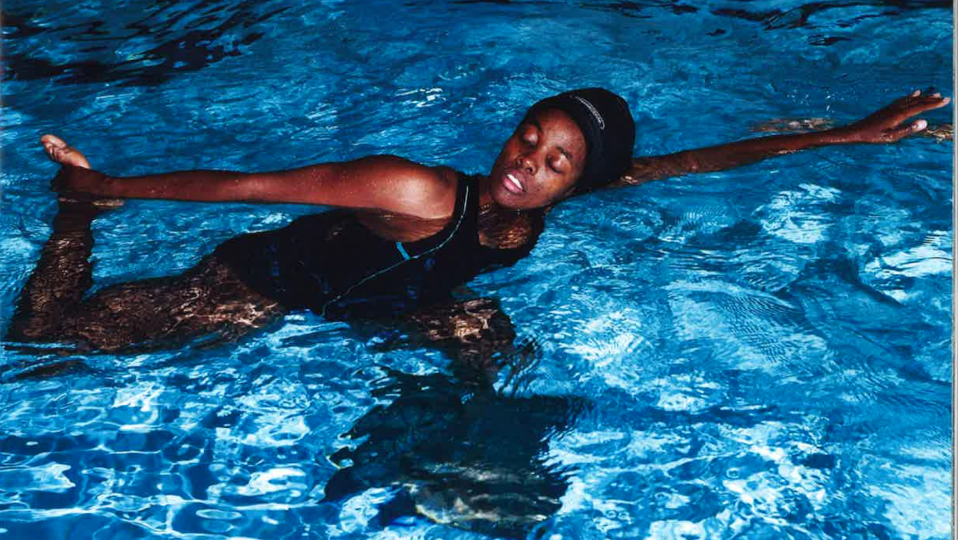
First published in Yoga & Health Magazine August 2013
Among recent developments in Western Yoga, Aqua Yoga seems particularly counter-intuitive. What about gravity and the grounding from the earth that makes us unfold the spine and find our elongation and strength? What about Yoga breathing in water? Besides, for many of us, water is associated with the fear of drowning rather than with floating bliss.
Yet across cultures humans have been drawn to water for healing, purification and re-creation for millennia. Ancient spiritual practices of initiation and divination were often located near springs, lakes or waterfalls deemed to be sacred. In these sites, immersion was ritualised. In both warm and cold climes, invigorating and relaxing baths have long been used therapeutically in natural pools with waters known to have special qualities. Roman baths, baptismal fonts and historical spas have been superimposed on some of these springs. In the last decades, the revival and expansion of spas around the world is not only due to modern technologies that make access to clean, warm pools possible. Spas also respond to our awareness that water can help us befriend our bodies and spirits, release tension and take care of ourselves in a relatively effortless way.
Forms of water exercise have also gained popularity in shallow swimming pools, either complementing Aquatic Physiotherapy or for gentle toning, avoiding impact and weight bearing. As Aqua Yoga defines its own space between relaxation in water, aquatic physio-therapy and aquatic fitness, it seems timely to explain why it is not another Yoga fad but an effective discipline that brings together the best of Yoga and water.
Like Yoga on land, Aqua Yoga makes extensive use of the breath in slow stretches. Rather than just using water resistance for muscle toning, in Aqua Yoga (and also in Ai-Chi, the translation of Tai Chi to water), an engagement is sought with water and its properties When we immerse ourselves and move in water, as beings whose make up depends on water, we enter a different world.
“Contributing to the pioneering of Aqua Yoga has been and still is one of my life’s main pleasures”
Françoise Freedman
Ideally, each Aqua Yoga session, even in the corner of a busy public pool, can re-create the primordial ocean, the water matrix of Vishnu. Contributing to the pioneering of Aqua Yoga has been and still is one my life’s main pleasures. As a long distance swimmer with a love of water from childhood, I treasured the ecstatic experience of getting into ‘the zone’, the space-time when moving and breathing combined become effortless in a gliding rhythm. The day when I recognised the same feeling in a Yoga class with Eva Ruchpaul in France, I knew that Yoga and swimming could be linked not just as complementary ways of stretching, but rather as one combined Aqua Yoga practice. Among leading teachers at the time, only Yesudian to my knowledge was interested in the relation between Yoga, health and swimming.
Besides swimming, it is probably my ‘messing about on/in rivers’ and also in lakes and seas that has been a main inspiration for developing aquatic adaptations of Yoga. Exploring the translation of asana to water is something I have enjoyed doing with fellow Birthlight aquatic tutors, most particularly Amanda Gawthorpe and also Shawn Tomlinson, Sally Lomas, Julia de Lucchi and Emie Kitson. This has been a collective playful creation.
Whenever I am in water, wherever I travel, whether out in the wild or in tamed pool waters, I always try new Aqua Yoga moves. While I continue with my conventional sadhana on land, for my teachers of Aqua Yoga are water creatures: the mammals, fish, amphibians and molluscs that inhabit aquatic environments. When we talk about ‘flow Yoga’, we have a lot to learn from the ways in which these amazing creatures move from their core, rotate and flip from front to back and upside down. At present my fascination is with otters both in East Anglia and in Peruvian Amazonia where giant otters have barely escaped extinction. In adapting asana to water, classic stances can be used to create additional resistance in the application of twists, bends and side stretches but these poses can also be rotated in flow sequences with fluid changes of planes.
Ideally, in Aqua Yoga the properties of water are best used without using one’s footing. When the body core becomes the centre of gravity and the foundation for body balance, stretches take on a different quality through the whole spine. Side rotations and, if one is sufficiently water confident and other rotations allow fluid transitions from one position to another in seamless succession with the possibility of floating stretches or even upright stretches that can be sustained in moments of stillness.
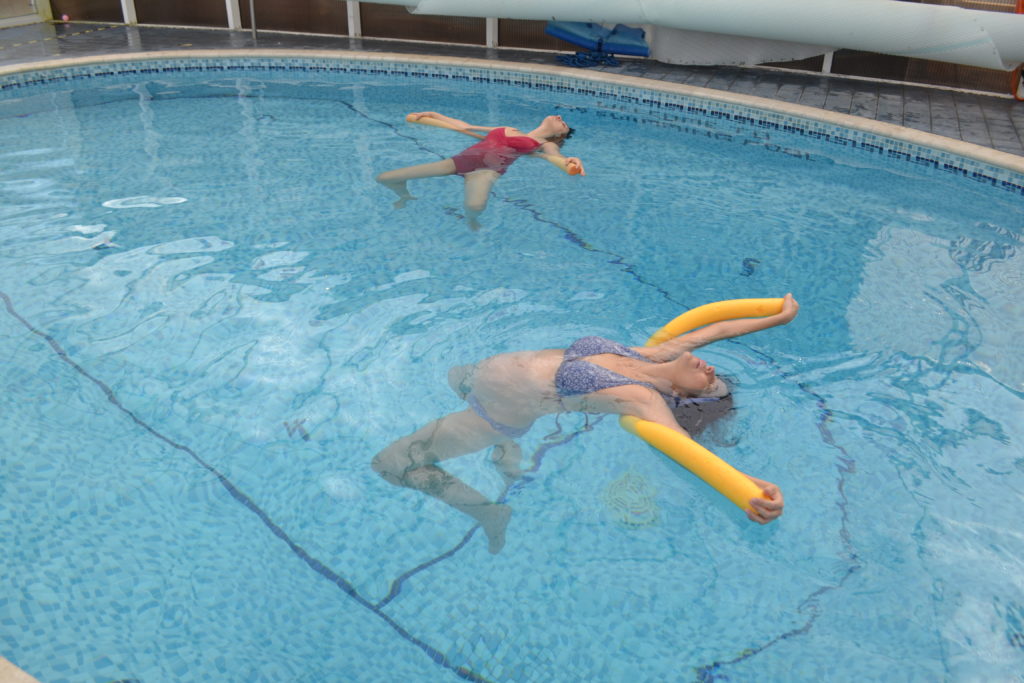
The creative use of floating aids and, most particularly, of versatile water noodles, allows even non-swimmers to progress rapidly from stabilising themselves away from bars and pool walls, to the point when they can allow the water to support them. Adjustments are then made in function of core balance rather than in response to gravity. Admittedly, further awareness of adjustments to gravity is precisely what Yoga encourages, but I would argue that developing movements from the core, like a sea anemone, or becoming aware of the outreach of extremities, like an octopus, as well as learning to undulate the spine like dolphins or porpoises facilitate the integration of whole body movements even for very unfit people and in some cases for people with reduced mobility
Practising Pawanmuktasana in water offers a wide range of opportunities to gain ownership of body balance and helps to build or rebuild strength in supporting structures surrounding impaired or weak body parts. This results in tremendous personal empowerment beyond physical improvements. Even more than on land, asanas can be done along a continuum ranging from very dynamic and energetic, using extremities like paddles or fins, to gentle self-nurturing restorative practices supported by floating aids. The characteristic that, to me, most differentiates Aqua Yoga from other forms of aquatic exercise is the fact that all movements are done with the body immersed at least to the shoulders and ideally the neck.
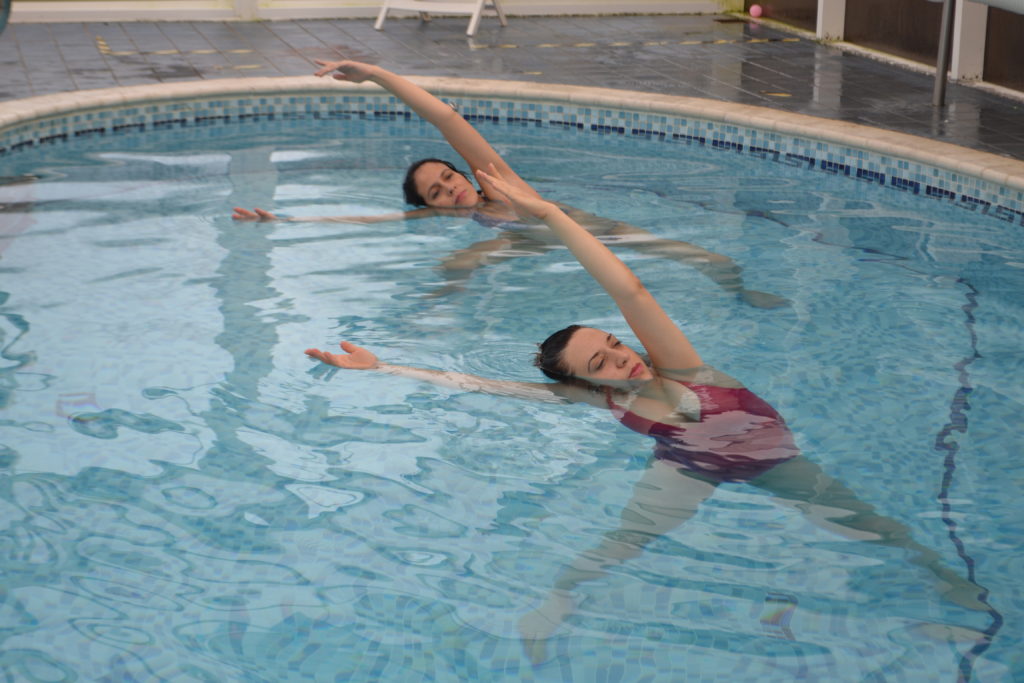
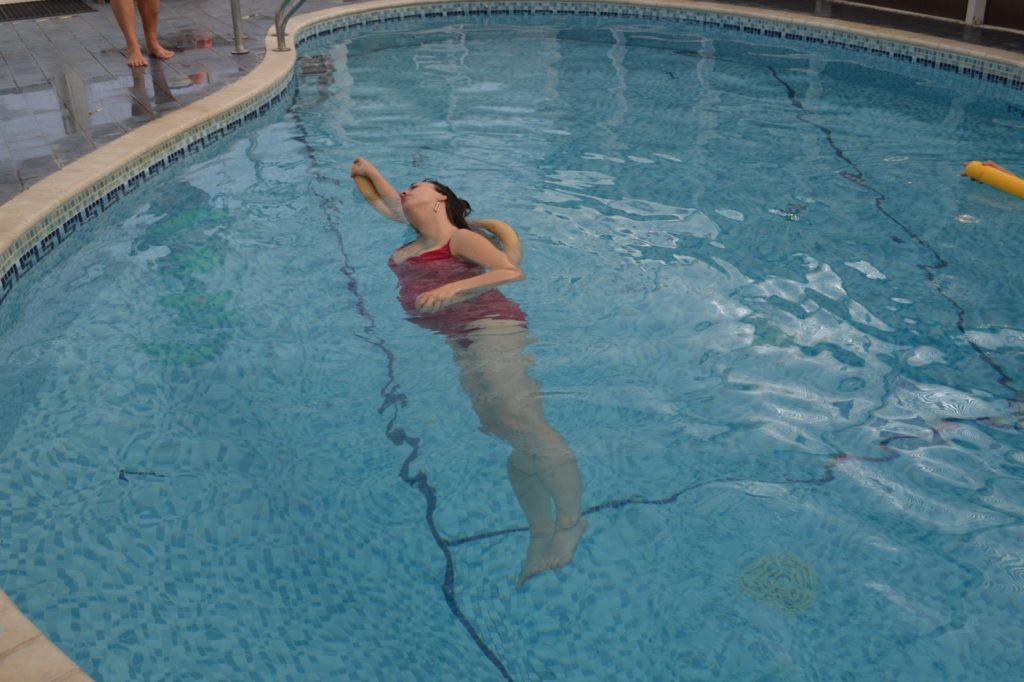
Not only the resistance offered by water increases considerably with every inch immersed above waist level but also when we are immersed, we are involving all the muscle chains and the connections between the diaphragm more easily and effectively. When we breathe with our lower jaw and the base of our necks in water, the experience of full Yoga breathing is immediate. A short cut access to bandhas is also created. Pelvic stability is pleasantly associated with more Do’s than Don’t in the water, although care is always required for those affected with hypermobile joints, but the range of motion is far less a concern than on land.
Aqua Yoga is best practised in environments where water temperature ranges from 31 to 34 degrees centigrade. Average swimming pools with water at 29 degrees may require wearing thermal clothing or at least including vigorous movement to keep warm. Water above 34 degrees can be pleasant to dip into but less suitable to move in and unsafe for pregnant women and senior citizens. Showering at regular intervals and drinking water is recommended if the water feels either too cold or too hot. Aqua Yoga sessions are shorter than land-based Yoga classes, with an average time of 45 minutes including several minutes of floating relaxation. This may seem a short time but the flow of an Aqua Yoga class includes a similar range of practices as those covered in a land class over 90 minutes.
Most asanas can be adapted to water but to me this is not the point of Aqua Yoga. If asana can be defined as creating a dynamic motion of the whole body-mind in stillness, then in water this motion is externalised, as it is generated in an environment that is also in motion. Through mindfulness we gain awareness of our rhythms in relation to the water environment. For this reason, excessive use of supports or standing poses in shallow water defeat the purpose. There are aspects of classic Yoga that are not amenable to Aqua Yoga, for instance Shoulderstand and Headstand, except for a diving yogi/ni who can use hydrostatic pressure and control their breath to hold their bodies in underwater inversions. Practising these with Russian fellow water lovers has been a rare treat. As Aqua Yoga teachers, however, our role is more to design adaptations that are true to the essence of Yoga yet accessible to beginners, most particularly for those with injuries or disabilities that prevent them from doing Yoga on land.
As a swimmer I have particularly enjoyed developing practices that take elements of swimming strokes and blend them with Yoga moves and poses. In Aqua Sun Salutes, glides and either simple turns or tumbles at the pool wall link moves on different planes through rotations. Yoga Walks in water, for instance alternating water-adapted Trikonasana and Parivrtta Trikonasana with forward steps, can become glides when feet are lifted from the pool floor. Back-stroke can integrate floating or Supta Baddha Konasana, whether supported by noodles or free floating. These practices are equally enjoyable with supports for non-swimmers to whom they give increasing confidence at the pre-swimming stages and for proficient swimmers who enjoy new stretches associated with their strokes.
Aqua Yoga and Swimming for Life
Various Aqua Yoga teachers have found that their skills helped them teach adults or frightened children.
Madeline Allen (Swimcats)
‘When nervous or non-swimmer adults come to me to learn to swim, I always start with Aqua Yoga. This is to help them get the feel of the water, what it can do for them: support them, create resistance and be their friend. Starting with some Aqua Yoga movements allows the swimmer to learn to breathe and more importantly to relax in the water.
I usually start with them gently walking through the water, maki sure they walk opposite arm to leg. It is amazing how difficult this when you need to think about it. As they become more confident, we lengthen the stride until they have their chin/mouth on or in the water blowing bubbles. This slowly develops into a swimming stroke, over a period of time.
Glides offer opportunities to expand breathing capacity with simultaneous mindfulness and surrender. As the glide is extended the limit of someone’s present ability, there is a choice to resist anc come up or to relax further. When we find the courage to relax, the glide is extended further. This wonderful realisation can transform habitual breath holding and release fear in a simple way, creating body memories that transfer to other aspects of our lives. I have found this practice to be particularly effective in preparation for childbirth or for people affected by PTSD (post-traumatic stress disorder). While free divers now use pranayama to improve their performance, easy and safe applications of aquatic breathing can benefit everyone, including non-swimmers.
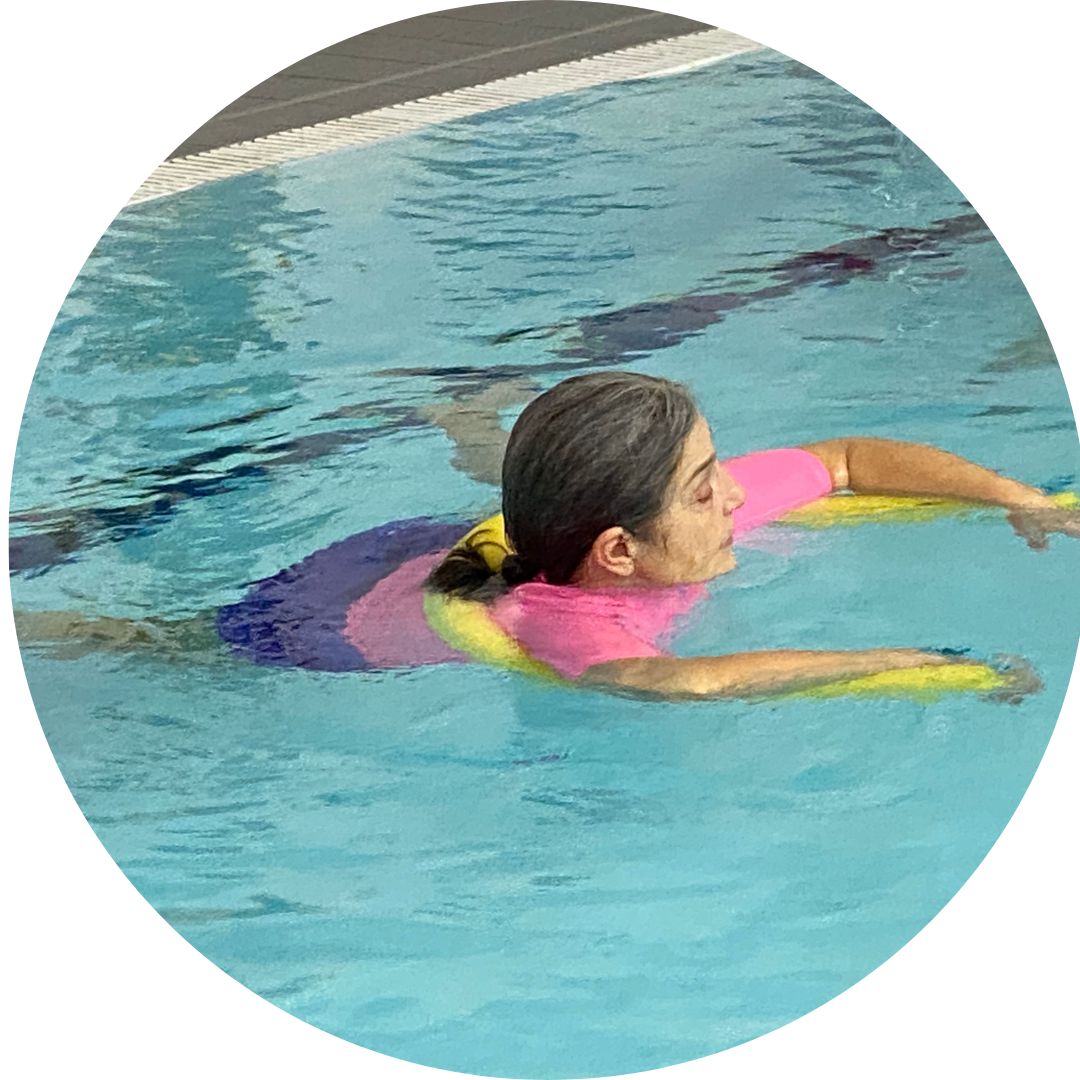
Aqua Yoga
Françoise Freedman
Dr Françoise Freedman is the Founder and Director of Birthlight. She is a pioneer, Senior Yoga Teacher, acclaimed writer and lecturer of Social Anthropology at the University of Cambridge.